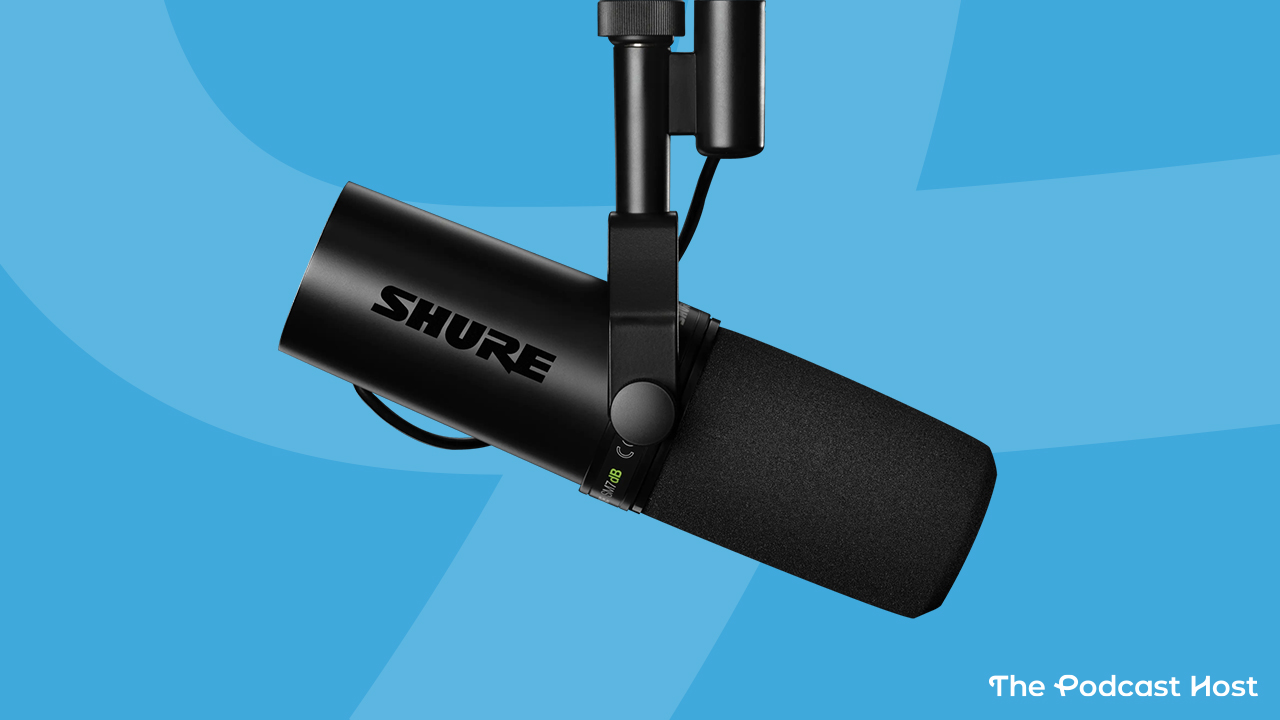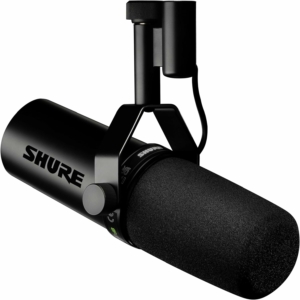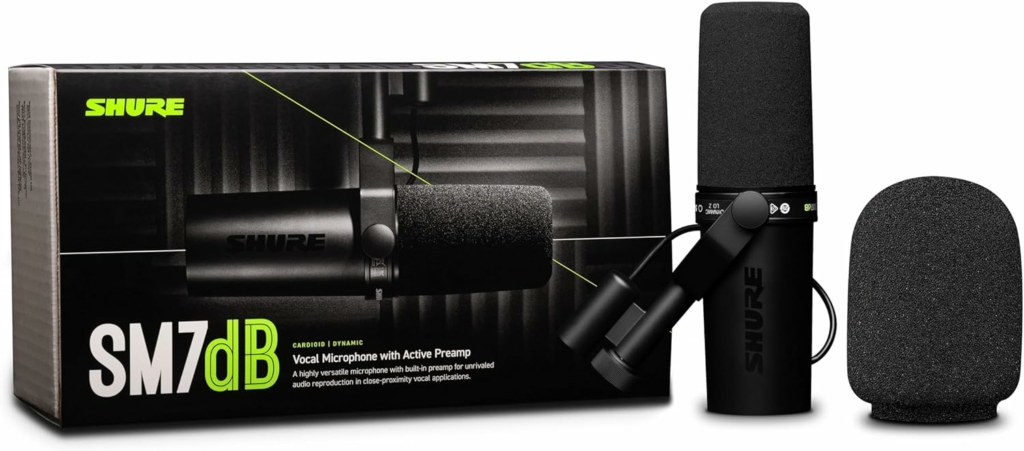Shure SM7db Review: Tame the Gain Chain

As Joe Rogan leans forward in his chair to make a point about ancient aliens bow-hunting elk and then discussing crypto in their cold plunge, you notice he’s using the iconic Shure SM7b microphone. You know that, if you only had that mic, you could get as many downloads as Joe. Then you realise the SM7b costs $400.
Well, what if I told you there was an alternative? The Shure SM7db.

Re-invigorated, you punch the name into Amazon, only to see this mic costs $100 more!
“This so-called gear reviewer is clearly an idiot”, you think. And you’re right. But there’s at least some logic to my claim here (it’s not really my claim, to be fair, it’s Shure’s). So if you’re still determined to own a mic with “Shure SM7” in its name, let’s get into it:
Heads up! This post uses affiliate links because that heating bill won’t pay itself, you know. Rest assured, though, we always give our honest opinion. If you choose not to buy through them it’s fine, we’ll just burn another book or something.
What is the Shure SM7db?
The Shure SM7db is basically the SM7b with a built-in preamp. That’s why there’s an argument that paying the extra $100 is saving you money.
And that leads us to the burning question…
Why Do I Need a Preamp?
The SM7b is one of the finest-sounding vocal mics on the planet. But, like a top-of-the-range racing car, it needs premium-quality fuel—and lots of it. I don’t want to overstay my welcome with this analogy, as I know almost nothing about cars (or mics, as you might currently be thinking), so let’s talk about gain.
Gain is your equipment’s input volume. The more you crank the gain up, the louder your signal (your voice) will record. A stronger signal helps you get the most from your SM7b, so adding a preamp (for example, the Cloudlifter) to your chain can achieve that.
Does My Audio Interface Already Have a Preamp Built-In?
XLR mics (like the Shure SM7b and SM7db) need to be plugged into an additional piece of gear. For podcasters, this will typically be a USB audio interface, a mixer, or a digital recorder.
Your device likely has built-in preamps; it’s whether they’re powerful enough that’s the issue.
A preamp’s gain-boosting capability is measured in dB (decibels). Now, you see where the SM7db got its name?
Shure states, “To connect an SM7 to a computer, you will need a digital audio interface with at least 60 dB of gain.” If a preamp, mixer, or audio interface offers 60 dB of gain, it means it can increase the level of an incoming signal by up to 60 decibels.
I use the Focusrite Scarlett 2i2 or the Maono PS22, both are USB audio interfaces. The PS22 gives me up to 60 dB of gain, whilst the 2i2 offers up to 69 dB. Whilst these technically provide enough “juice” for the SM7b, I don’t think either could run it optimally. And you only invest in a mic like the SM7b if you’d like to sound optimal.
I also have a Zoom PodTrak P4, which offers up to 70 dB of gain, and I’ve seen some reports of folks using this with the SM7b and getting satisfactory results. One device that should be more than up to the task is the Rode Rodecaster II, with its giddy heights of 76 dB gain. But then, the Rodecaster II costs a lot of money.
So that, children, is why most owners of the SM7b plug in an additional preamp between their mic and interface of choice.
But, this is an SM7db review, and that’s exactly the problem the mic was built to solve. Let’s get to know it a little more…

Setup & Features of the Shure SM7db
The SM7db—just like the mic it’s cosplaying as—is a dynamic model. Mics are typically built in either “dynamic” or “condenser” form. Dynamics plug in and work right away, while condensers need an additional setting known as Phantom Power.
The SM7db is the first dynamic mic I’ve ever used that requires Phantom Power. Fortunately, providing it is as easy as pressing a button on your interface, mixer, or recorder. Phantom Power is usually marked as “48v” and, once activated, will let that much-coveted built-in preamp kick in.
There are also some little switches on the base of the mic where you can toggle certain settings:
Bass Rolloff Switch: If you’re not all about that bass, you can cut some of it from your recording. This is handy for lessening the impact of plosives and can help eliminate unwanted background noise, from AC units to cars passing by outside.
Presence Boost: One of those “make me sound nicer, will you?” buttons.
Bypass Switch: Pretend you’re using an SM7b by turning off the very feature you bought the SM7db for.
Preamp Switch: Set your gain to +18 dB or +28 dB. If you’ve been paying attention so far, you’ll know exactly what this means.
How Does the Shure SM7db Sound?
At that price, I’d be outraged if the answer was “horrendous”. But the SM7b is widely considered to be one of the best-sounding mics in the world, so there wasn’t much chance of that.
Sadly, it’s me that’s talking into it, which is the great leveller for any mic.
I recorded via my Maono PS22 because the mic isn’t a Shure SM7b.
I was really impressed by the way it sounded in an untreated room and by its rejection of plosives.
It also rejected my daughter, which sounds like a terrible thing to say. But in the specific case of recording audio, this is a good thing.
Cost of the Shure SM7db
We’ve been through this, have we not? At the time of writing, the Shure SM7db will cost you $499 to pick one up brand new on Amazon or £449 if you fancy a long swim.
For comparison, the SM7b is $399 or £379, but… well, all that preamp stuff we talked about. Read it again if you have to.
Remember, although the Shure SM7db includes a preamp, you’ll still need other gear to run it. That chiefly means a USB audio interface, mixer, or digital recorder. An XLR cable too. A boom arm wouldn’t go amiss, either.
The Shure SM7db is a major investment, no matter how you frame it.
Summary: Should I Buy the Shure SM7db?
That’s entirely up to you, Champ. But here are my takeaways:
- If you’re an “I must have the best possible gear” type of podcaster, and can afford it, then yes.
- If you’re an “I must have the best possible gear” type of podcaster, and can’t afford it, then no.
- If you already own an SM7b, then, no.
- If you’re a “good enough gear” or “make do” podcaster, then, no.
I can see why audio enthusiasts love this mic; it truly is class. But the Shure SM7db’s impact will be minimal outside of your own wee recording bubble. Most podcast listeners don’t know or care what we’re recording into, as long as it sounds fine in their earbuds and audible enough on that bus, train, or busy street.
That said, if you find joy in premium gear and setups – and, have the budget to back it up – then fill your boots. I’m sure the Shure SM7db will make a lovely addition to your studio.
Our Rating: 4/5
- Performance: 5/5
- Ease of Use: 4.5/5
- Affordability: 2.5/5
If you’re still looking to shop around for a mic, then our best podcast microphones roundup is a post where the purpose should be entirely clear from its title.
